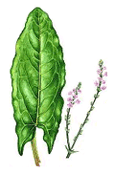
Butchers Broom
Introduction
This fact sheet provides basic information about Butcher's Broom. Butcher's broom is a low-growing common evergreen shrub. It is widely distributed, from Iran to the Mediterranean and the southern United States. The plant develops edible shoots from rhizomes that are similar to asparagus in form. Butcher's broom has been used in many forms as a laxative, diuretic, treatment for circulatory disease, and cytotoxic agent, although limited results from clinical trials are available.
Common Names
Butcher's Broom, Box Holly , Knee Holly, Pettigree, Sweet Broom , Jew's Myrtle
Latin Names
Ruscus aculeatus
What It Is Used For
- Chronic venous insufficiency
- Atherosclerosis
- Hemorrhoids
- Varicose veins
- European herbal doctors have used butcher's broom for centuries to alleviate constipation and excess water retention.
- Butcher's broom has been used as a mild diuretic and laxative, though other drugs are now considered more effective.
How It Is Used
In traditional medicine, both the root and stem of the plant are used in herbal preparations.
What the Science Says
- The German Commission E approves oral use of the rhizome for supportive therapy for discomforts of chronic venous insufficiency and complaints of hemorrhoids and reports no known interactions. In a clinical trial, no adverse events were attributable to therapy by the 40 patients evaluated.
Side Effects and Cautions
- Information regarding safety and efficacy in pregnancy and lactation is lacking. Avoid use.
- Burdock is generally considered a safe and edible food product. A few reports have appeared on burdock root tea poisoning (blurred vision, headache, drowsiness, slurred speech, loss of coordination, incoherent speech, restlessness, hallucinations, hyperactivity, seizures, disorientation, flushing, dryness of mouth and nose, rash, lack of sweating, fever) due to adulteration with atropine-containing plants.
Sources







